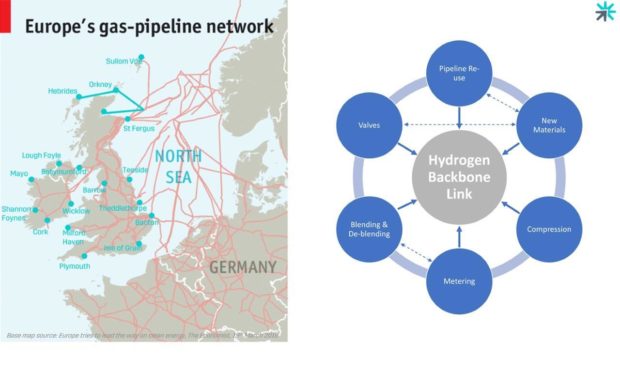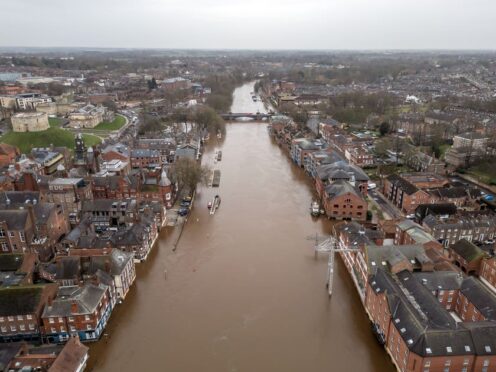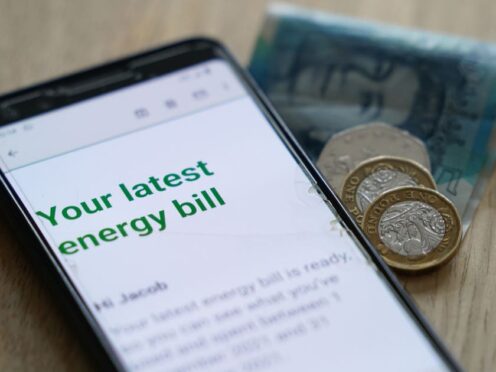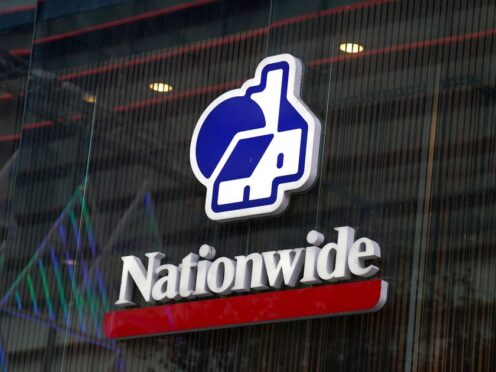The production and export of hydrogen to consumers will play a key role in the UK reaching its climate objectives and net-zero targets.
To help make this a reality, affordable hydrogen transport is the focus of a new project part-funded by the Scottish Government and led by the Net Zero Technology Centre (NZTC).
The proposed Hydrogen Backbone Link will position Scotland in a leading role for the development of pan-European hydrogen infrastructure, creating export capability by repurposing and optimising existing pipeline infrastructure both on and offshore.
The project will consider how a hydrogen pipeline network could be established between the Energy Hub, another of the government-backed projects NZTC is working to develop, and the existing national grid as well as ports and other energy infrastructure.
It is estimated the Hydrogen Backbone Link could create around 800 jobs, although this could be higher depending on the scale and reach of the ambitions realised.
Repurposing oil and gas for hydrogen
Martyn Tulloch, NZTC head of energy system integration, said: “Affordable hydrogen transport is fundamental, with a huge opportunity for the oil and gas sector to support in the development of the hydrogen economy, by repurposing existing infrastructure.
“There will be a large North Sea focus. We are looking at the offshore pipeline network in particular and how can we repurpose some of that to get low carbon hydrogen to meet European demand.”
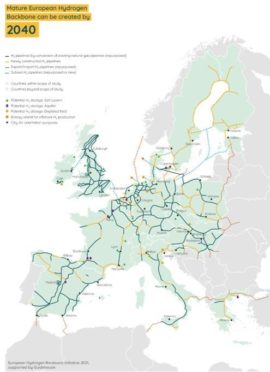
The Hydrogen Backbone Link project recently received £1.6million of funding from the Scottish Government with some of that to be matched by industry.
A total of £600,000 has been awarded for the 12-month, phase one of the project.
This will involve feasibility studies, building a consortium and developing links with potential customers in Europe.
One of the studies will involve looking at the possibly of building new pipelines with Mr Tulloch describing it as perhaps more “economic and advantageous”.
A further £1 million has been allocated for phase two which will see the shortlisted technologies from phase one deployed and developed.
Mr Tulloch said: “Potentially if we look at realigning pipelines, we could have technology that could be exportable. That’s one of the big focuses here.”
Technical challenges in the pipeline
Mr Tulloch says they have identified six technical challenges to developing the backbone but work is already underway to get them right.
“Hydrogen is a smaller molecule and it’s got complications when you transport it through existing networks,” he said.
“It can cause embrittlement of carbon steel and that can cause cracks in pipelines, so we are looking at either realigning existing pipelines, potentially using new materials.
“It also causes challenges for valves and compressors. Because it’s such a small molecule, it can leak out through natural gas seals in compression equipment, so we look at bespoke equipment for hydrogen.
“There’s also metering challenges. How do you measure how much is actually being transported?
“That’s an area where we’ve got a number of technology developers working already.”
Mr Tulloch believes there’s also the potential in the short term to use ships to transport hydrogen from Scotland to Europe.
He said: “That will be another area we will be looking at. Although we’ve got the pipeline focus we are looking at other transportation methods as well.”
Laying foundations for global markets
As these challenges are worked out in the North Sea, the potential to export the knowledge provides significant opportunity.
He said: “We can look at repurposing the North Sea pipeline network but some of the same challenges are going to be faced by pipeline infrastructure across the globe.
“Even some of the offshore technologies we are looking at here could be deployed in onshore pipeline networks.
“We are laying the foundations for a market that should develop from the late 2020s onwards.
“Time is on our side to a certain extent but if we don’t start looking at this now I think we might miss the opportunity when it does arise.
“It really has to develop if Europe wants to get to net-zero. Europe needs low carbon hydrogen to replace fossil fuels. They need huge quantities of low carbon hydrogen.
Time is on our side to a certain extent but if we don’t start looking at this now I think we might miss the opportunity when it does arise.”
“This is not looking at a small demonstration project that will be available in the next two to three years. It’s looking at the big infrastructure repurposing that we need to get to net zero from 2030 onwards.”
The feedback so far has been encouraging and Mr Tulloch believes there’s huge potential for partners to be involved in both the backbone and the Energy Hub.
He said: “Some of the partners, for example gas network operators, may only be interested in the hydrogen backbone but most of them are going to be interested in both.
“There’s a lot of excitement and people like the scale of ambition here and the strategic importance of it as well.
“It’s comparable to the early days of oil and gas when there was a huge investment in pipeline infrastructure to connect supply with demand.
“We are hoping to do exactly the same here. We’ve got the best renewable energy resource in Europe off the coast of Scotland, but how do we connect those energy hubs into European demand? That’s the question we are trying to answer here.
“Every other project is looking at producing hydrogen and we are looking at how do we get the hydrogen from all the other projects into Europe where the demand is.
“We are looking at the large scale repurposing of the offshore pipeline network.”
What is the net zero technology transition programme?
Initial funding for the Hydrogen Backbone Link project comes from the Scottish Government via its £62 million Energy Transition Fund.
The NZTC was recently awarded £16.5m from the fund to develop seven schemes through its net zero technology transition programme (NZTTP) , which it claims could deliver £403billion for the economy and 21,000 jobs by 2050.
With industry agreeing to more than match that level of funding, a total of £34 million will be invested in projects aimed at “transforming the North Sea energy system” and delivering a net-zero future.
In addition to the Energy Hub and the Hydrogen Backbone Link, there are also schemes looking into robotics, data sharing and remote operations technology.
Another initiative involves the development of turbines — used to power oil and gas platforms — which can run on clean fuels, as opposed to natural gas.
NZTC was originally founded in 2016-17 as the Oil and Gas Technology Centre, backed with £180 million worth of Aberdeen City Region Deal funding over 10 years.
